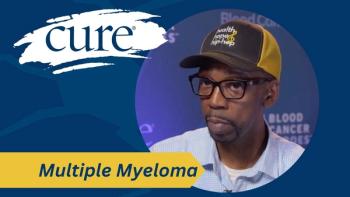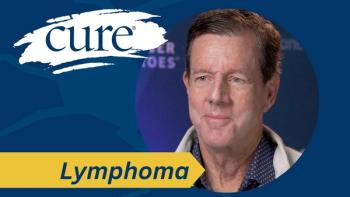
Learning About Advanced Prostate Cancer

Transcript:
Kristie L. Kahl: There's been a high survival rate in prostate cancer over time, but with distant prostate cancer, those rates can significantly drop. Can you discuss how metastatic prostate cancer is different?
Dr. Charles Ryan: Metastatic, when applied to a cancer, implies that the cancer cells started in the organ of origin, which in this case is the prostate. The most common site of cancer prostate cancer spreading or metastasizing is to the bone or to the lymph nodes. Less commonly, it can go to the liver or the lung.
So, what are the different stages of advanced prostate cancer? Well, I think prostate cancer can be divided into a number of different ways. Stage is something that typically refers to where the cancer has gone in relation to the organ of origin. So, stage 1 prostate cancer, for example, would be a tumor that's confined to the prostate. A stage 2 prostate cancer would be cancer that has gone to the edge of the prostate or has gone through the capsule of the prostate, perhaps. Stage 3 is more locally advanced through the capsule even to the regional lymph nodes. Stage 4 would be prostate cancer that's spread to a distant organ, such as the bone. But in my daily practice, I don't talk about these stages that much because what really matters is two things with regards to the outcome of a patient with advanced or metastatic prostate cancer: Factor number one is has it spread outside of the prostate that we can see on a scan like a bone scan or the CAT scan. Factor number two is it resistant or sensitive to the hormonal therapy that we typically use?
When we talk about a life-threatening form of prostate cancer and you hear somebody who dies of prostate cancer, those patients are typically patients who have both of those phenomena. The cancer spreads typically to the bone and standard hormonal therapy stops being effective. And the cancer begins to grow, despite the lowering of testosterone. That’s not to say that there aren't treatments for that entity. There are a lot of treatments for that entity.
Kristie L. Kahl: Can you discuss the current standards of care for advanced prostate cancer?
Dr. Charles Ryan: There are many different types of treatments for prostate cancer. In fact, the number of treatments for prostate cancer has really exploded in the last four or five years and it's actually going to get even bigger in the next few years. So, that's good news but when we think about the standards of care, I would say we can divide it into three or four categories.
Hormonal therapy, the standard of care would be some form of ablation of the level of testosterone in the body. We typically do this with injections that lower the level of testosterone by about 90%. The most commonly used drugs would be leuprolide, (Zoladex [goserelin]), (Trelstar [triptorelin]), (Vantas [histrelin]) and (Firmagon [degarelix).
On top of that, we have second-line hormonal therapies that also block the effect of testosterone but they're effective in doing it even when the first-line of therapies have failed. That’s where we have drugs like (Xtandi [enzalutamide], (Zytiga [abiraterone]), (Erleada [apalutamide]) and (Nubeqa [darolutamide]). Those are targeted hormonal therapies compared to some other cancers.
We use relatively little chemotherapy but we do have some very effective chemotherapies. There’s one called docetaxel, which can be used in advanced hormone-resistant disease or can be used in upfront metastatic disease. We have a drug called cabazitaxel, which has a similar set of indications.
The new class of drugs that we're using now are the PARP inhibitors, which are those that are targeting the mechanism of DNA repair in prostate cancer.
We have a cellular therapy called sipuleucel-T, which is used in castration resistant metastatic disease. We have a radioisotope called radium-223, which is used in bone metastatic disease typically in patients with bone pain.
Kristie L. Kahl: Why is treatment adherence so vital when it comes to these regimens?
Dr. Charles Ryan: Treatment adherence has to do with whether the prescribed medication actually gets into the patient. We can lose adherence for a number of reasons. One is a patient could take a bottle of pills home, put in his medicine cabinet and never take it. There's not much we can do about that as the doctors. But it could be, for example, that a patient starts to take a pill medication for his cancer and because he doesn't feel so good, he stops taking it. That’s a different story we would want to hear about. We want to know why he doesn't feel well and whether we could reduce the dose or give a treatment break. That’s what we do as oncologists. That's our job.
Adherence for an injected drug is, of course, high if a patient shows up and has the drug injected into them. It’s a situation where adherence is almost 100%, but the reality is all the research in the world that leads to the development of a new therapy isn't effective if we don't get it into the patient. It is a dialogue between the doctor and the patient about what can or cannot be administered and why it may not be one factor.
Unfortunately, a problem in this country is that patients sometimes bear a lot of the cost of their medication. It could be that they're getting an oral medication and they have a significant copay, for example.So, not being able to pay the copay would be one risk for a patient not adhering to the treatment regimen. That is something that I, as a doctor, would want to hear about. I wouldn't want a patient to keep that from me because again we can think about ways for patient assistance programs if they exist in your area. Or we can think about ways we can reduce the dose and do other things that might to allow us to as effectively deliver the drug, perhaps on a slightly different schedule or a slightly more cost-effective one.
Kristie L. Kahl: How have oral options helped to improve quality of life for men?
Dr. Charles Ryan: It is nice to have oral therapies available. I would say that, for the most part, the oral therapies that we use in prostate cancer are reasonably well tolerated with some exceptions. And they require maintenance monitoring by the doctor. There’s no drug with zero side effects at all. So, it's something that patients need to be honest with and they need to share with us about what's going on so that we can make adjustments and help them with regards to quality of life.
I'll say, the major driver of quality of life in advanced prostate cancer is the efficacy of the therapy and this has been shown, for example, with chemotherapy. Many men might think chemotherapy is going to be associated with a very poor quality of life but in a study that was done many years ago, in which newly diagnosed patients with metastatic disease were treated with standard hormonal therapy with chemotherapy. The patients who were on the chemotherapy had a slightly lower quality of life after about three months of treatment, but after 12 months of starting treatment the patients who had received the chemotherapy had a better quality of life. That was because 12 months after starting the treatment, the patients had already been done with the treatment for six months and they were less likely to have their cancer worsening. Better cancer control leads to better quality of life.
It’s not a uniform outcome that chemotherapy is associated with a worse quality of life. It’s not always the case that oral therapy has no side effects or that they are associated with better quality of life.
Kristie L. Kahl: Can you discuss some trials going on in the space right now?
Dr. Charles Ryan: There are many trials that are going on. I would put clinical trials into one of two categories. Category one would be optimization studies using therapies that we know that exist but maybe we're testing them in an earlier disease population, maybe we're looking for a better outcome by giving it to patients with a lower volume of disease. So, for example, there are studies where we use enzalutamide and abiraterone, these are two very commonly used drugs that when they first started to be administered, they were given to patients who had received all prior therapies and chemotherapy, but then we showed that we could give them to patients with CRPC who did not have chemotherapy and then we showed that we could give it to newly diagnosed patients. The outcomes were better than giving standard hormonal therapy alone. Now, the studies that are going on are looking at patients who do not have metastatic disease but they might have a PSA that's detectable and rising after surgery or they might even be patients who are at high risk but getting radiation therapy and do not have any sign of metastatic disease either. That has been a general principle in oncology for decades and the best example of that is probably breast cancer, where we have seen 30 or 40 now years of clinical research which has taken medicines that work in very advanced forms of the disease and have given it now to women even before they have their breast removed or their tumor removed from their breast. It leads to improvements in outcome. We’re optimizing prostate cancer therapy use. We're moving them earlier in the disease spectrum. We're maybe changing doses, etc.
The next type of clinical trial would be new therapies and new approaches. It’s always really fun to be a clinical scientist and to be thinking about new approaches to the treatment of cancer. And prostate cancer is a really good example.
If you ask me what would probably be the most up-and-coming novel therapies for prostate cancer, I would think of three of them that come to mind right away. The first would be the PARP inhibitors, which have only been approved for about two months. Those are relatively new and I think there are a lot of clinicians out there who still don't have any experience with these therapies. The two that are approved currently, one is called (Lynparza [olaparib]) and the other one is called (Rubraca [rucaparib]).
The second category that's really exciting is PSMA-targeted therapies. We have one that's looking really interesting. It's been in a number of clinical trials, many of them have been done outside of the United States, notably in Australia where they've done a lot of this amazing work where they've shown that a molecule that targets PSMA, which is not the same as PSA. It’s a different thing on prostate cancer cells. This molecule is really interesting. On one end it binds to PSMA and then on the other end it has this molecular basket and in this basket you can put a molecule. In this case, it's lutetium 177, which is a radio isotope. It's one atom of radioactivity
and you put it on the targeted treatment. It hand delivers the radiation therapy to the prostate cancer cell. That looks really interesting and there's a major trial called the VISION trial and others that are going to be reading out in the United States in the next few months to the next year that might lead to the FDA approval of this agent that's available in other countries.
There's another, less known genetic genetic-based study of a drug ipatasertib. That is a drug that targets a molecule called AKT. AKT is an activated circuit or pathway in the prostate cancer. When the cancer has a certain mutation, a mutation of a gene called p10. That’s a very common mutation of prostate cancer. If that mutation is activated and stimulating the cancer, the drug blocks AKT. So, that’s a phase 3 trial that is in the process of completing and we might hear data on that in the coming year. That could be something that could become available for prostate cancer patients, most likely in the advanced castration resistant metastatic setting.
Kristie L. Kahl: What do patients with advanced prostate cancer have to look forward to most?
Dr. Charles Ryan: It’s an exciting time for those of us who are treating this disease because we begin to see multiple different options for synchronizing our treatment with where the patient is in the disease. Some of the drugs that we saved until very late in the disease spectrum we're now giving early. That’s a good thing because we're able to knock out more of the cancer when it's less aggressive and it's in a lower volume. We started, maybe 20 years ago now, thinking about this idea of personalized medicine and targeted therapies. We're kind of there. We’re not quite there totally, and what I mean by that is the idea that a patient could go to his doctor. His doctor can take his tumor and take him in terms of who he is and what his other medical problems and his age and his other needs are. They can analyze his tumor and can prescribe a medication that would be appropriate for that. We are certainly able to do that in some cases now and it's very gratifying because it's nice to be able to say I did a test on your tumor and it tells me not only about your prognosis but it tells me this about a therapy that I want to use. So, we're getting there. I think it's still a bit off that we'll get to the point where every patient has some unique profile that comes up with some special cocktail of treatment. I think that's still a little bit far off but we are seeing the beginning of this process.
Transcription edited for clarity.




